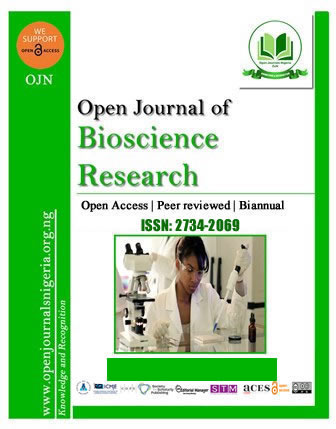HAEMATOLOGICAL EVALUATION OF SPRAGUE-DAWLEY RATS INFECTED WITH PASTEURELLA MULTOCIDA AND ADMINISTERED BDELLOVIBRIO BACTERIOVORUS (ATCC™ 1534) AS THERAPY
DOI:
https://doi.org/10.52417/ojbr.v1i1.55Keywords:
bdellovibrio, bacteriovorus, control, haematological, Pasteurella multocida, ratsAbstract
The effects on haematological parameters of Sprague-Dawley rats infected (challenged) by the injection of pathogenic Pasteurella multocida and the administration of Bdellovibrio bacteriovorus (ATCC™ 1534) as therapy, occasioned by the consideration of its use as an alternative to antibiotics, due to the high rate of bacterial resistance to current clinically used antibiotics was investigated. A total of 60 rats, divided into 5 groups (4 experimental groups and 1 control group) of 12 rats each were used in this study. The first group of 12 rats were injected subcutaneously with one millilitre of 1 x 108/ml B. bacteriovorus (ATCC™ 1534). The second group of 12 rats were injected with one millilitre 108/ml of P. multocida in saline. One millilitre each of 108/ml of both P. multocida and B. bacteriovorus (ATCC™ 1534) were injected into another set of 12 rats in the third group. The third group of 12 rats were injected once intra-muscularly, in the hind flank muscle, with 2 mg/kg of Ketamine Hydrochloride. And lastly, one set of 12 rats were not injected with any bacteria served as control. In all cases, observed haematological data were analysed from the experimental rats after 168 hours (except rats which were injected with 2mg/kg ketamine hydrochloride, used as anaesthetic, (at sacrifice), and compared with the haematological profiles of the 12 control rats. Results shows a reduction of mortality from 9 to 1 (88.8%) of rats challenged with P. multocida over those inoculated with B. bacteriovorus and P. multocida was observed. WBC counts were higher (4.12 x 103/µL) in B. bacteriovorus and P. multocida over WBC counts in control rats which served as WBC reference values. Though, not statistically significant (ANOVA = p >0.05). In a similar comparison, RBC counts (6.5 x 103/µL) were lower than observed in control rats, while platelet counts (1138 x 103/µL) were higher than values in controls, however, this was statistically significant. Moreover, haemoglobin concentrations were lower (11.7 g/dL) than in control rats. Though there were slight variations in haematological profiles from reference values, it was concluded that B. bacteriovorus seems to have no life-threatening effect on haematology of rats. However, evaluations such as observed platelet increases on inoculations of B. bacteriovorus, need to be addressed before the promise of its in vivo use in controlling Gram-negative infection in animals and humans can be tapped.
Sar, T. T. | Department of Biological Sciences, University of Agriculture, Makurdi, Benue State, Nigeria
Published
How to Cite
Issue
Section
Copyright (c) 2020 Sar et al.

This work is licensed under a Creative Commons Attribution 4.0 International License.





















